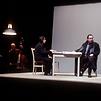: The staging
The staging
Christian Colin
I am trying to write in a simple and concrete way, and at the same time, I'm hoping to touch on the large questions of life.
Jon Fosse
In Le Nom, as in all his plays, Fosse maintains an extreme minimalism - the "movements" of the characters are almost erased. Fosse is above all a master of silence, but without didacticism. Le Nom does not speak of the sociological problem of the inability to communicate, but rather the incommunicability of the human essence. It is a silent tragedy in which language is no longer used to express thoughts or to make a request. On the contrary, the word becomes a sort of consolation for the pointlessness of living, acting and understanding.
What matters to Fosse is "the perfect form". He seeks a language that is both simple and artistic, but he also sets out to compose a particular rhythm of word and silence. All his plays have something diabolical, dark and mysterious, but (like with Beckett or Bernhard), they also have moments of comedy and marks of irony.
The thing is to highlight these paradoxical elements. The staging will not move in the direction of a kind of naturalism, but towards poetic realism, towards a description of life that is largely authentic, treating the themes of the text with sensitivity - the unexpressed desires of the girl, the profound anxiety of the boy, the terrible pain of the mother, the insomnia of the father, the melancholy of Bjarne, but also the comic aspects of the family and of life in general. It is in the interpretation of these topics that we are going to be able to explore the underside of this theatre of silence.
The stage design
On the basis of Fosse's non-resolved dramaturgy, we have chosen an open stage: a flexible space that is both simple and concrete, like Jon Fosse's writing. From the beginning, we have the feeling that the story has already taken place. The stage design depicts a fragmented mental space, offering memory the possibility of moving around and at the same time questioning art itself.
Since the problem of interior and exterior is an important element in the writing of Fosse, the stage design respects this difference in the unity of place. Here, it is a space where objects are isolated within the whole, an arrangement that creates strong images around Jon Fosse's obsessions, the sofa, the rain, nature, art, the house, photography.
At the back of the stage, a white canvas behind which, at the end, can be seen an image from memory: a rainy, black-and-white landscape, livened up by children playing with erased images, which could (perhaps) remind of a painting by Lars Herterving, an artist admired by Jon Fosse, protagonist of his novel Melancholia, and one of the most famous Norwegian painters, who expressed a Nordic romanticism of nature by painting pictures as "silent" as the texts of Jon Fosse.
The music
The music is something very important for me. I am constantly seeking the rhythm of my language. This is revealed in the circular movement of my plays.
Jon Fosse
According to Fosse, writing is more a musical act than an intellectual one. "The man with a guitar" is the title of another play. In his youth, Fosse obsessively practised the guitar and when he began to write, he transposed his relationship with music to language. Writing facing the sea, he was particularly interested in sound, in understanding through feeling and especially in the rhythm of language. Influenced by such writers as Rilke, Trakl and Thomas Bernhard in particular, he treats key phrases as leitmotivs in a musical work: eternal repetitions to make a round. On the basis of this particularity of Fosse's work, Peter Kowald, double bass player and star of free jazz, will listen to the musical rhythm of Le Nom. Not to fill the silence but on the contrary, to make audible what is left unsaid. Every evening, Peter Kowald will improvise live, seeking a new musical interpretation of the "Fosse" score.
Ces fonctionnalités sont réservées aux abonnés
Déjà abonné,
Je me connecte
–
Voir un exemple
–
Je m'abonne
Ces documents sont à votre disposition pour un usage privé.
Si vous souhaitez utiliser des contenus, vous devez prendre contact avec la structure ou l'auteur qui a mis à disposition le document pour en vérifier les conditions d'utilisation.


